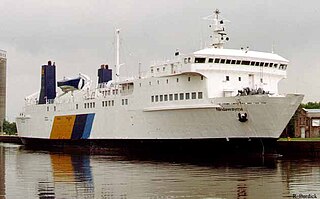
The MV Manx Viking / Nindawayma was a passenger, truck and car ferry, whose last active service was on Lake Huron, operated by the Owen Sound Transportation Company; under contract to the Ontario Ministry of Transportation. In Canadian service she served the Highway 6 route between Tobermory and South Baymouth, Manitoulin Island from 1989 to 1992 alongside the MS Chi-Cheemaun.

The Isle of Man Steam Packet Company Limited is the oldest continuously operating passenger shipping company in the world, having been founded in 1830.

The Isles of Scilly Steamship Company (ISSC) operates the principal shipping service from Penzance, in Cornwall, to the Isles of Scilly, located 28 miles (45 km) to the southwest. It provides a year-round cargo service together with a seasonal passenger service in summer. The name of the company's principal ferry, the Scillonian III, is perhaps better known than that of the company itself.

SS (RMS) Ellan Vannin was built as an iron paddle steamer in 1860 at Meadowside, Glasgow for the Isle of Man Steam Packet Company. She was originally named Mona's Isle - the second ship in the company's history to be so named. She served for 23 years under that name before being rebuilt, re-engined and renamed in 1883. As Ellan Vannin she served for a further 26 years before being lost in a storm on 3 December 1909 in Liverpool Bay.

The Caledonian MacBrayne fleet is the largest fleet of car and passenger ferries in the United Kingdom, with 34 ferries in operation, 2 on charter and another 6 on order. The company provides lifeline services to 23 islands off the west coast of Scotland, as well as operating routes in the Firth of Clyde.
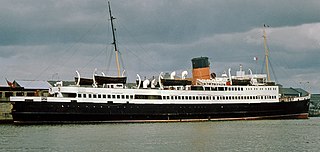
Turbine Steam Ship (RMS) Manxman was a passenger ferry launched from the Cammell Laird shipyard, Birkenhead, on 8 February 1955. She was the final vessel in a class of six similar ships, the Six Sisters, ordered by the Isle of Man Steam Packet Company, and was the second of the Company's ships to carry this name. She was withdrawn from service in 1982. Following a failed preservation attempt, and featuring in a music video in the process, the ship was broken up at Sunderland in 2012.

TSS (RMS) King Orry (IV) - the fourth vessel in the line's history to be so named - was the lead ship of the King Orry Class of passenger ferries and packet ships. More commonly referred to as the six sisters, they were built for the Isle of Man Steam Packet Company between 1946 & 1955 primarily to replace war-time losses. The company's previous King Orry was one of three company losses during Operation Dynamo - the evacuation of British and French troops from the port of Dunkirk during May 1940.

TSS (RMS) Mona’s Queen (IV) was a passenger vessel operated by the Isle of Man Steam Packet Company from 1946 to 1962. Sold to the Chandris group in 1962, she was adapted for cruising and operated as Carina and, from 1964 Fiesta until scrapped in Greece in 1981.

TSS Snaefell V - the fifth ship in the Company's history to bear the name - was a passenger vessel operated by the Isle of Man Steam Packet Company from 1948 to 1978. Her purchase cost was £504,448.

TSS Mona’s Isle V, the fifth ship in the line's history to bear the name, was a passenger vessel operated by the Isle of Man Steam Packet Company from 1951 to 1980. She was the last of the company's ships to use low pressure turbines.

TSS (RMS) Manx Maid (II) was built by Cammell Laird at Birkenhead in 1962, and was the second ship in the Company's history to bear the name.
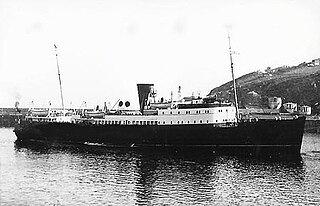
TSS (RMS) Fenella (II) No. 145310 was a pre-Second World War passenger steamer built by Vickers Armstrong at Barrow-in-Furness in 1936, for service with the Isle of Man Steam Packet Company. She was sunk by air attack during the evacuation of Dunkirk in May 1940.
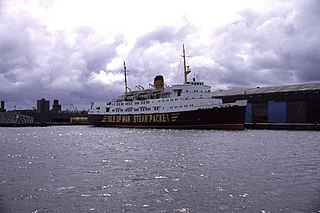
TSS (RMS) Ben-my-Chree (V) was the second of four side-loading car ferries ordered by the Isle of Man Steam Packet Company. Built in 1965, she was the last of their vessels designed with two classes of passenger accommodation and the fifth company vessel to bear the name. She operated until 1984 and was broken up in 1989.
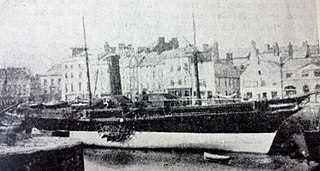
SS (RMS) Tynwald (I), No. 21921, was an iron paddle-steamer which served with the Isle of Man Steam Packet Company, and was the first vessel in the Company to bear the name.

SS (RMS) Tynwald (II), No. 45474, was an iron paddle-steamer which served with the Isle of Man Steam Packet Company, and was the second vessel in the Company to bear the name.
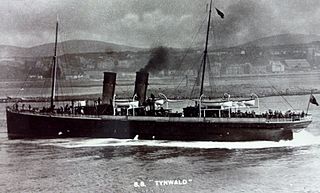
SS (RMS) Tynwald (III), No. 95755, was an iron passenger steamer which served with the Isle of Man Steam Packet Company, and was the third vessel in the Company to bear the name.

SS (RMS) Victoria was a packet steamer originally owned and operated by the South Eastern and Chatham Railway Company, who sold her to the Isle of Man Steam Packet Company in 1928 for the sum of £25,000.
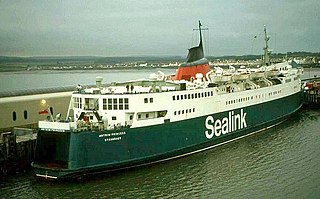
MV Tynwald was a roll-on-roll-off car and cargo vessel operated by the Isle of Man Steam Packet Company between 1986 and 1990, the sixth ship in the history of the line to bear the name. Built as Antrim Princess for service on the Stranraer–Larne route, she was chartered under her original name until 1986.

SS Mona's Isle was a steam turbine passenger ship that was built in Scotland in 1905 as Onward, renamed Mona's Isle in 1920, and scrapped in Wales in 1948. She was designed as an English Channel ferry for the South Eastern and Chatham Railway (SE&CR), who operated her between Folkestone and Boulogne. In 1920 the Isle of Man Steam Packet Company (IoMSP) bought her and renamed her Mona's Isle. The IoMSP ran her mainly on summer services linking Douglas with Dublin and Belfast. She was the fourth IoMSP ship to be called Mona's Isle.

SS (RMS) Mona's Isle (III), No. 76304, the third ship in the company's history to be so named, was a paddle steamer which served with the Isle of Man Steam Packet Company until she was purchased by The Admiralty in 1915.






















